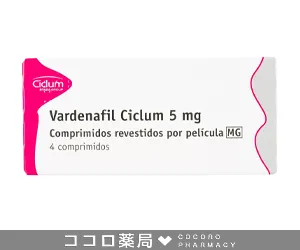個人差はあると思うけど、自分は10分くらいで効いてきてくれる。急いでる時でも使えるから助かるね~勃起力もバッチリだからリピートしてる。

左記クレジットカード、銀行振込、コンビニ決済に対応





更新日:2025/4/19

| 個数 | 販売価格(1錠あたり) | 販売価格(箱) | ポイント | 購入 |
|---|---|---|---|---|
| 10錠 | 192円 | 1,920円 | 57pt | |
| 50錠 | 172円 | 8,640円 | 259pt | |
| 100錠 | 153円 | 15,360円 | 460pt |
| 個数 | 販売価格(1錠あたり) | 販売価格(箱) | ポイント | 購入 |
|---|---|---|---|---|
| 10錠 | 162円 | 1,620円 | 48pt | |
| 50錠 | 166円 | 8,340円 | 250pt | |
| 100錠 | 150円 | 15,060円 | 451pt |
| 個数 | 販売価格(1錠あたり) | 販売価格(箱) | ポイント | 購入 |
|---|---|---|---|---|
| 10錠 | 242円 | 2,420円 | 72pt | |
| 50錠 | 182円 | 9,140円 | 274pt | |
| 100錠 | 158円 | 15,860円 | 475pt |
| 個数 | 販売価格(1錠あたり) | 販売価格(箱) | ポイント | 購入 |
|---|---|---|---|---|
| 10錠 | 262円 | 2,620円 | 78pt | |
| 50錠 | 186円 | 9,340円 | 280pt | |
| 100錠 | 160円 | 16,060円 | 481pt |






①1万円以上で送料無料
1回の注文で10,000円以上だった場合、1,000円の送料が無料となります。
まとめ買いをすると1商品あたりのコストパフォーマンスが高くなるためおすすめです。
②プライバシー守る安心梱包
外箱に当サイト名や商品名が記載されることはないため、ご家族や配達員など第三者に内容を知られることは御座いません。

③100%メーカー正規品取り扱い
当サイトの商品は100%メーカー正規品となっており、第三者機関による鑑定も行っております。
商品の破損などがあった場合は再配送などにて対応させて頂きますので、ご連絡頂ければ幸いです。

④いつでも購入可能 処方箋不要
サイト上では24時間いつでもご注文を受けております。
また、お電話によるご注文も受け付けておりますのでネットが苦手な方はお気軽にどうぞ。

⑤商品到着100%
商品発送後はお荷物の追跡状況が分かる追跡番号をご案内させて頂きます。
郵便局には保管期限がありますのでご注意ください。
・自宅配達で不在だった場合の保管期限・・・16日間前後
・郵便局留めとした場合の保管期限・・・7~30日間

⑥コンビニ決済利用可能
ご近所のコンビニにていつでもお支払可能です。
セブンイレブンに限り店舗での機械操作を必要とせず、手続き完了後に表示されるバーコードや払込票番号をレジに提示することでお支払い頂けます。

ビリトラ 20mg x 10錠
1,920円
ポイント:57pt
10,000円以上購入で送料無料
在庫あり

| 商品名 | レビトラ | バイアグラ | シアリス |
|---|---|---|---|
| 効果時間 | 5~10時間 | 4~5時間 | 12~36時間 |
| 発現時間 | 15~30分 | 30~60分 | 60分 |
| 副作用 | 少ない | 少ない | 非常に少ない |
個人差はあると思うけど、自分は10分くらいで効いてきてくれる。急いでる時でも使えるから助かるね~勃起力もバッチリだからリピートしてる。
他のEDジェネリックよりも効かない。ゼリーと錠剤両方試したが、どちらも効かなかった。今度はレビトラも飲んでみて、レビトラでも同じ感じだったら、レビトラでのED治療はやめる予定。
効果自体に違いはありません。同じ成分を配合したジェネリックであるため、ビリトラを服用してもレビトラと同様の効果に期待できるようになっています。そのため、レビトラをお使いの方は遜色なくビリトラもお使いいただけます。
カロリーが高い脂っこい食事は影響を及ぼすことがあります。脂肪分が多い食事はビリトラの成分吸収に影響を及ぼし、十分な効果を得ることができなくなったり、効果があらわれるまでの時間が長くなったりすることがあります。
空腹時に適切な方法で服用するのが最も大切です。適切な量を適切に使うことで最大限の効果を得ることができます。裏を返せば適切でない使い方や量は効果を弱めたりすることにも繋がるので注意してください。
即効性の高さがビリトラの最大の特徴となっています。服用後15~20分という短時間で効果があらわれることから、急な性行為のチャンスを逃すことなくものにすることができるようになっています。
他のED治療薬と一緒に服用しないでください。ED治療薬はそれぞれ同じような作用を持っているためです。他のED治療薬と一緒に飲んでしまうと効果が重複してしまい副作用のリスクが高まってしまいます。
24時間の間隔をあけている場合、毎日服用して問題ありません。ただし、24時間未満の場合は毎日使うことはできないので注意するようにしてください。連日の服用を計画している場合は、服用間隔に注意するようにしてください。
ビリトラは1回あたり1/2錠(バルデナフィルとして10mg)が適切な用量となっています。また、副作用などとの兼ね合いを見ながら最大20mgまで増量することが可能となっています。
カロリーや脂肪分の少ない食事の場合は食事の影響を受けないとされています。しかし、カロリーが高かったり脂肪分が多かったりした場合は食事の影響を受けるため、食後に服用する場合は2時間ほどの時間を空けることが推奨されています。
起立性低血圧や狭心症などはそこから事故などを引き起こす可能性があります。また、失明などに繋がってしまう緑内障の報告もあるため、危険な副作用といえます。ビリトラを服用してこれらの危険な副作用があらわれた場合には、速やかに医療機関を受診してください。
正常な勃起によって感覚が鈍る可能性があります。通常、男性器は勃起の強さに応じて感覚は鈍っていきます。ED気味で十分に勃起ができない方がビリトラを服用し、正常に勃起できるようになると感覚が鈍って快感が減ったように感じることは考えられます。
誰でも使える薬ではありません。持病がある方や特定の治療薬を服用している方の使用は禁忌とされています。ですから、ビリトラを用いてED改善を考えた時は、まず自身がビリトラを服用することができるかを確認するようにしてください。
安静時の血圧が、上が170mmHg、下が100mmHg以上の方は使用が禁忌となっています。適切な治療や服薬で血圧をコントロールできている場合は、使用できる場合もあるため、自身が使用できるかどうかは事前に医師に確認するようにしてください。
| 1日の服用回数 | 1回 |
|---|---|
| 1回の服用量 | 10mg |
| 服用のタイミング | 性行為の約1時間前 |
| 服用間隔 | 24時間 |
| 商品名 | ジェビトラゼリー | シラグラ | シアスマ | ビタラ | バリフゼリー | バリフ | レビスマ | バリマックス | バルデナフィル(Ciclum) |
|---|---|---|---|---|---|---|---|---|---|
| 商品画像 |  |  |  |  |  |  |  |  |  |
| 特徴1 | ・バイアグラと比べ食事の影響を受けにくい | ・インドで有名な製薬会社シプラが製造 | ・日本語パッケージで安心 | ・1回の服用で5~10時間ほど効果が続く | ・レビトラジェネリックのため即効性が高い | ・レビトラジェネリックの中で最も有名 | ・レビトラのジェネリックだから低価格 | ・レビトラジェネリック | ・3大ED治療薬であるレビトラと同成分を配合 |
| 特徴2 | ・ゼリータイプなので水なしでも服用できる | ・ピルカッターの使用でさらに費用対効果向上 | ・バイアグラ系ED治療薬より作用がマイルド | ・性的興奮を覚えたときに効果を発揮する | ・7つのフレーバーがあり飲みやすい | ・レビトラよりも安価に購入できる | ・日本語パッケージで安心 | ・安価でEDを改善できる | ・比較的スピーディーにED改善効果を得られる |
| 内容量 | 20mgx7包 | 50mgx4錠 | 20mgx4錠 | 20mgx10錠 | 20mgx7包 | 20mgx10錠 | 20mgx4錠 | 10mgx4錠 | 5mg4錠x1箱 |
| 価格 | 2,800円 | 2,460円 | 2,220円 | 1,900円 | 2,700円 | 2,310円 | 2,220円 | 2,000円 | 4,360円 |
| 1%以上 | 0.1〜1%未満 | 0.1%未満 | 頻度不明 | |
| 循環器 | ほてり(10.6%)、心悸亢進 | 頻脈、高血圧 | 失神、低血圧、顔面浮腫、心筋虚血、心筋梗塞 | 起立性低血圧、狭心症 |
| 精神神経系 | 頭痛(11.7%)、めまい | 不眠症、異常感覚、傾眠、眩暈、感覚鈍麻 | 不安、緊張亢進、一過性全健忘 | |
| 肝臓 | 肝機能検査異常、γ-GTP上昇 | |||
| 呼吸器 | 鼻閉 | 副鼻腔うっ血、呼吸困難、鼻出血 | ||
| 筋・骨格系 | 背部痛、筋肉痛 | 関節痛、頸部痛 | ||
| 皮膚 | 紅斑、発汗、そう痒、光線過敏性反応、発疹 | |||
| 消化器 | 消化不良、嘔気 | 腹痛、口内乾燥、下痢、胃炎、嘔吐、胃食道逆流 | 嚥下障害、食道炎 | |
| 感覚器 | 視覚異常、結膜炎、霧視、羞明、彩視症、眼痛、耳鳴、流涙 | 緑内障 | ||
| その他 | CK上昇、灼熱感、無力症、胸痛、異常感、勃起増強(勃起時疼痛等) | インフルエンザ症候群、射精障害、アナフィラキシー反応、持続勃起 |
本製品は海外製のため、期限表記が日本と異なる場合がございます。
パッケージ裏面や側面、シートなどに以下のような表記がされています。
| EXP | 使用期限 例:EXP 12/2025→2025年12月まで使用可 |
|---|---|
| MFG または MFD | 製造日 例:MFG 03/2023 |
| BEST BEFORE | 品質が最も安定している目安日 |


※国や製品により日付の並び(例:月/年、日/月/年)が異なる場合がありますのでご注意ください
EXP(Expiry Date) の表記がなく、MFG または MFDしか記載がないケースがあります。
この場合は MFG(MFD) から2~3年が使用期限の目安です。
※「LOT」や「BATCH」の表記は製造番号であり期限ではありません。

パッケージ例となります。
商品やご注文単位によってはシート単位でのお届けとなる場合が御座います。
外箱に当サイト名や商品名が記載されることはないため、ご家族や配達員など第三者に内容を知られることは御座いません。
最初に飲んだ時は頭痛がきつすぎてエッチどころじゃなかったんだけど、飲む量を調整したら副作用も出ないし、いい感じに勃つ感じだしでいいことづくめでした。これなら普段使いもよさそう。
最近ED気味で彼女とのセックスも憂鬱でしたけど、これを仕込んで臨んでみたら普段よりも硬くなってるしいい感じでした。彼女の方もいつも以上の硬さに喜んでくれてました(笑)
初めてこの間使いましたが、この即効性は侮れないね…。ちょっとした興奮ですぐにガッチガチになっちゃって逆に恥をかくほどでした。ただ、そのまま1錠だと副作用がでたんで、飲む量は注意した方がいいかも。
副作用はあるけど気にはならない程度です。半立ちだった息子が、これを飲むとビックリするくらいに硬くなったので気に入りました。奥さんなんて痛いって言うくらいだから、それぐらい硬くなります。笑
個人差はあると思うけど、自分は10分くらいで効いてきてくれる。急いでる時でも使えるから助かるね~勃起力もバッチリだからリピートしてる。
商品口コミの投稿は会員のみ行えるようになっております。
お手数ですが会員ログインの上でご投稿頂きますようお願いいたします。
口コミをご投稿頂いたお客様にはポイントをプレゼントさせて頂いております。
文章のみであれば100ポイント、文章+写真付きのものは300ポイントをプレゼントさせて頂きます。
規約や詳細などはこちらをご確認くださいませ。